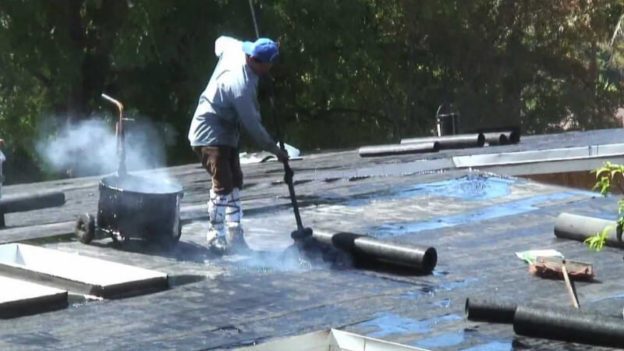Did you know that tar, specifically hot tar, is a really useful material for many roofing solutions? If you don’t already know the term hot tar roofs or know how useful tar can be for your roof, then you’ve found the right article for you.
In it, we’re going to look at a number of things tar can do for your roof, as well as how to work with tar if you’re considering doing it yourself. Safety is paramount here and you should really have some experience working with this sort of material or else you should call out a professional. However you decide to work with tar, it can be a great way to repair a roof.
These days, roofs can need repairing for all sorts of reasons. Wind and other weather damage is one of the main reasons, along with general wear and tear and old age. While you might think your roof should last ages, it might not.
But getting a new roof can be really expensive. Instead of paying for a complete tear-off job or major roof repairs, simple patching up can add years to the lifespan of your roof. And it’s much cheaper, too. So let’s have a look at some of the benefits of roof tar as well as some important points that are associated with it.
hot tar roofs – Using tar to patch your roof
If water is coming through your roof, you’re probably in a bit of a panic. Leaks can cause a lot of damage and can be really stressful. Some roofers might have recommended expensive roof repairs or even a complete re-roofing job.
But this is often expensive, and might not even be necessary. That’s where tar can help. Roof tar can be applied to your roof to fill the gaps and hopefully plug the right holes. While this shouldn’t be done on really damaged roofs, it can help fix the problem in the short-term.
Hot Roof tar can even be applied while it’s still raining. While this raises a number of safety issues (more on those later), it does mean you can quickly fix the problem while the storm is still going.
Unlike getting a new roof put on or extensive repairs—where you’d have to wait for a dry period. However, some roofing professionals do not recommend tarring when it’s wet. This can be a short-term solution that might dramatically impact the overall lifespan of your roof. You should only do it in extreme situations. However, dry tarring is much better, and could help your roof considerably…
When might you need to tar a roof?
- Rain damage
- Leaks
are the main reasons many people decide to tar their roof. It’s a cheap and affordable option for fixing the problem in the short to medium term. But what are you looking for when you get up on your roof to look for damage and problems?
Look for things like missing caulk or other issues around your flashing, as well as cracked or broken shingles (or completely missing ones). You might also want to have a look at your chimney to see if the lead is rusting or missing. All of these things can be fixed with some tar.
These problems CAN be fixed with tar, but not every roofer will recommend doing it yourself;. Some consider it a short-term solution to a problem that will come back soon enough. Tar is a great temporary solution, but not always a long-term one.
Benefits of tarring a roof
- The main benefit of tarring a roof, as we’ve already looked at, is that it’s quick, easy and affordable.
- You can even do it yourself (if you’re careful).
- Even if you hire a roofer to do it, it shouldn’t cost too much and can be done in an hour or two. While it isn’t the most long-lasting solution to roofing issues, it’s good for people who just need to patch up minor problems and don’t have a lot of money to spend, or want something done quickly.
- You can even tar a roof during heavy rain which makes it a good option for fixing issues during a storm before more extensive repairs can take place.
- Roof tar is great against UV rays and is a durable material. A tarred roof can be quite resistant against heavy winds and precipitation like snow.
Drawbacks of tarring a roof
While roof tar has a number of benefits, there are some drawbacks as well.
- Firstly, it isn’t particularly long-lasting. Many roofers think that a tarred roof won’t really last that long. It might just be patching up a problem that will come back after a while, and it could even come back even more seriously as the tarred parts are opened up.
- Roof tar can also give off fumes that aren’t safe to inhale and could cause major health issues.
Hot Tarring a roof
If you’re going to tar your own roof, be careful. Make sure you have the right tar for your particular roof as well as the right weather condition. Some tars can be applied in the wet, but most can’t. So if you’ve got a normal tar, you need to wait for some consecutive pleasant days and until your roof is completely dry.
Tarring a roof has a number of safety issues associated with it. Firstly, getting on top of a pitched (or any type of) roof can be dangerous. Make sure you’ve always got the right safety equipment and that you know what you’re doing. Tethering a safety harness is recommended, as well as have help holding ladders. If you haven’t done this sort of work before or have any concerns, then leave it to a professional. Don’t get up on your roof while it’s windy or if you can’t keep stable. Never take undue risks.
The tar itself can also present problems when working with. Never tar something indoors or in an area that isn’t fully ventilated. Always use a face mask and be careful when applying the tar. Don’t get too close to it and don’t get any on you. These are all standard precautions. If you aren’t sure you can do a safe and secure job, hire a professional roofer.
*feature image and video from YouTube












